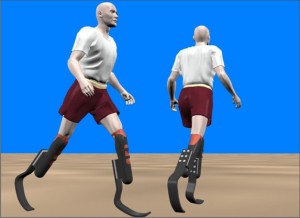
Honestly, when people think about how scientists are going to change an athlete’s level of fitness in particular and sports in general, they often picture a cocktail of steroids and other banned substances that might not show in a urine test. And can you blame them? Since the news is full of athletes who have tainted their illustrious careers and accomplishments by using performance enhancing drugs. But, how times have changed, new generation of prosthetic limbs are promising to change sporting competition as we know it and here are the deets.
Remember the guy who came out in an exoskeleton during the Opening Ceremony of the 2014 FIFA World Cup, well latest prosthetics have been which not only enable disabled people to jump but also run possibly even faster than Bolt.
Genium X3
The Genium X3 is considered as the most advanced prosthetic leg in the world. The newest technology to treat amputees has been developed by the US military and fitted with a highly advanced micro-processor, the X3 is able to adjust according to the user’s stride pattern, and also various forms of movement such as, jogging, climbing stairs, and maneuvering through a range of difficult terrains. But, more importantly, the built-in micro-processor has been designed to adapt to different sports and activities. Virtually impenetrable by sand, dust and water, the X3 uses the same motion sensors which are used in smartphones and the Wii.
i-limb
And what about the golfers out there? The i-limb ultra, designed by Touch Bionics has five fingers which are able to articulately move independently by bending at the natural joints so that it is able to grasp any object gently and firmly.
The best feature of this high tech technology is that the user is able to gradually increase the strength of their grip, which comes in handy for picking up heavy weights. The grip patterns of the i-Limb include an index finger which can also be used for typing and a pinch mode which enables the user to hold small objects firmly.
Apart from that, the i-Limb also features a selection of hand gestures which allows athletes to communicate on the field. Powered by Biosim-i and Biosim-Pro software, the i-Limb communicates with the hand via a Bluetooth connection, which enables the user to customize the prosthetic according to their daily activities. The prosthetic comes in two low-profile sizes, which are, regular and small, and also comes with an improved battery system which is extendable to up to 25% and features an audio warning signal whenever the battery runs low.
Ending Note
For more action of all the newest technology in the sporting arena you will have to wait for the 2016 Cybathlon, which will be held in Switzerland and will feature all the power-assisted devices and prosthetics that are used in new sporting competitions. In fact, organizers of the even expect that athletes with prosthetics could even outstrip able-bodied athletes. A good example can be given of Amputee long jumper Markus Rehm who won the German National Championships with a jump of 8.24 meters using carbon-fiber blades.
